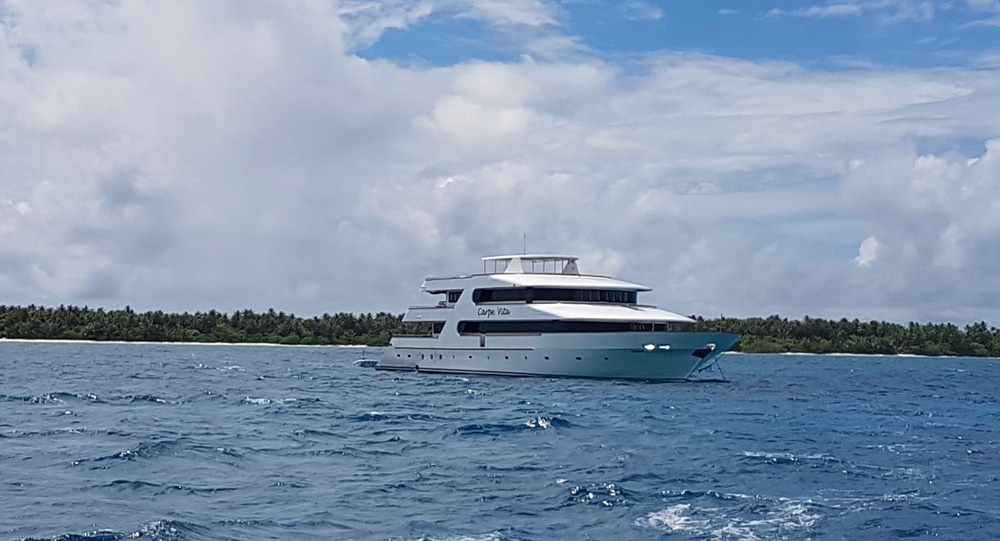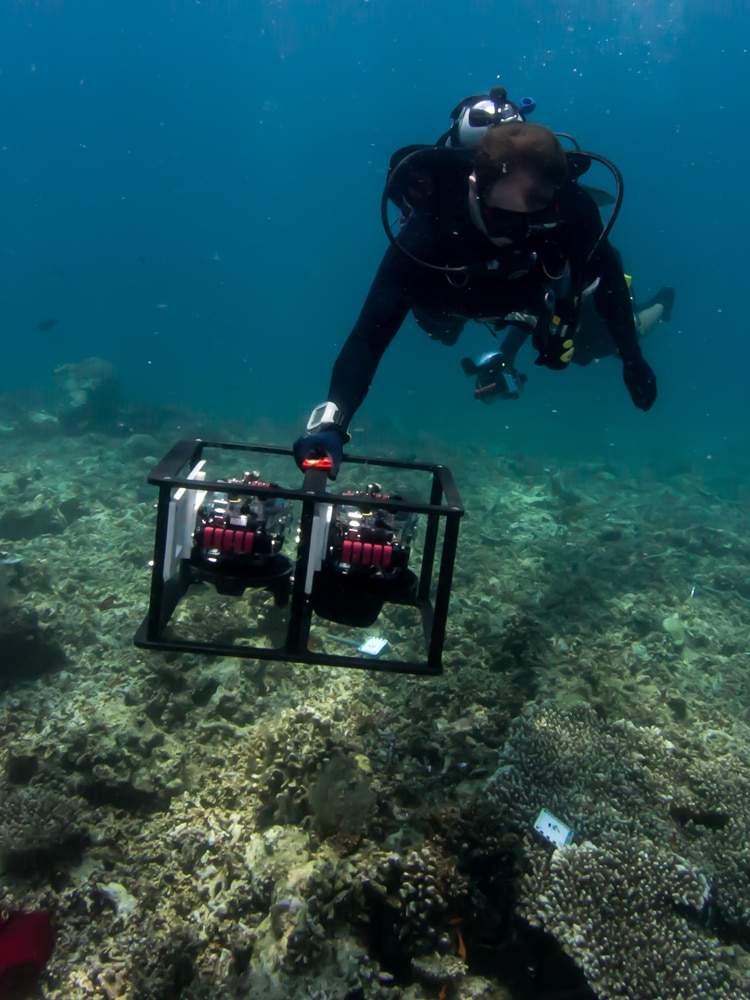News
Carpe Diem: Dive with a Purpose 2018, with the 100 Island Challenge

Scubaverse Contributor Yo-Han Cha reports from his recent liveaboard trip in the Maldives…
It’s been stunning out here in the Maldives. In the first two days we saw mantas and a whale shark – not a bad start to a week on a liveaboard, in fact it was beyond anything I expected. It was a dream start to the trip and Mother Nature and the Carpe Diem staff have certainly delivered.
But this trip wasn’t just about us having fun and enjoying the underwater wildlife of the Maldives, Carpe Diem had us diving with a purpose and we had Brian Zgliczynski and Clinton Edwards from the Scripps Institution of Oceanography, UC San Diego who were here as part of their 100 Island Challenge campaign.
What is the 100 Island Challenge?
To quote Scripps:
“No two coral reefs are the same, and no two reefs will face the future in the same way. This variability, however, can teach us lessons about how to manage coral reefs for the best future possible.”
The 100 Island Challenge is a five year campaign where they’ll aim to survey 100 islands and to resurvey them every two years to plot any changes. 81 islands have been surveyed so far with some of them have already had their two-year resurvey. The 100 Island Challenge team is aiming to complete 95 by the end of 2018.
One of their main methods of data collection is using photogrammetry to survey the reef – other methods being benthic and fish biomass assessments – but on this trip, there was a focus on the photogrammetry. For those of you who are unfamiliar with what it is, photogrammetry is where hundreds, if not thousands, of photographs are processed by computer software to produce a 3D model.
I had come across it before to survey wrecks but it’s not something I’d ever attempted before. This has proved to be an excellent tool for surveying coral reefs as they don’t move, and by surveying the same site over time, the Scripps team have been able to monitor, not just a single snapshot of coral population and distribution but the growth, death and regrowth of the exact same corals in a specific area of the reef.
Which brings us back to the Maldives, with Brian and Clinton here to firstly see if the Maldives was somewhere suitable for the 100 Island Challenge and to test their camera equipment. We, the non-scientist guests, were encouraged to take our cameras and with a brief instruction before the start of the dive, go survey a small coral for ourselves.
Brian and Clinton were using DSLRs and today they mounted two of them together (quite a sight!) in order to survey a section of the reef in a 5m x 5m grid. Nobody else on the trip had a DSLR to take underwater and none of were expected to do a grid survey, but four of us, with four different makes and models of camera, ranging from a simple compact to a mirrorless, went out, chose a coral and gave it a go, not really knowing what the end result would be.
Due to our different cameras, some of us had to approach it slightly differently. I shot in continuous mode and kept the trigger down whilst I swam steadily around my coral. After years of photography where I’ve been told to shoot into the blue for good negative space and to shoot up, the most difficult part of me was to go against my instincts and avoid having any blue in the shot and to shoot down! However, the award for having the most patience and diligence went to Daphne as she individually took over a hundred images of a coral with her compact.
The results for all four of us were in my opinion amazing and I’m not just saying so because one of them’s mine. Considering that due to time constraints Clint processed the images at a lower resolution than he would do normally (Scripps are going to process them at full resolution when they get back to San Diego) and that we were total novices to this, the results were a lot more detailed than I expected them to be, which is exciting in more than one way as it shows that this method of surveying is one that can be easily trained to others.
We’re now, sadly, just over halfway through our trip. The diving, the staff and the liveaboard have been excellent and it’s been exciting to learn how we, each in our small way, can make a difference.
For more information on the 100 Island Challenge click here.
For more information about Scripps Institution of Oceanography click here.
For more information about Carpe Diem click here.
Gear News
Introducing the TR-80, IR-50 and CS-30 Regulators from DYNAMICNORD

Whether you are a beginner or a professional diver – with the three new main regulators from DYNAMICNORD, everyone will find their favourite regulator. They all look super stylish.
Excellent performance with the TR-80
Quality and performance are the be-all and end-all for regulators. It is not for nothing that the TR stands for Tec Reg. The innovative design of the TR-80 guarantees absolute reliability – even in ice-cold waters.

Perfect breathing effort at 0.8 J/l / certified for diving in waters below 10 degrees / structural design made of solid brass for best cold protection / membrane-compensated design with dry seal of the first stage / reduced exhalation effort thanks to optimized exhalation membrane and bubble deflector / adjustable Venturi (dive/predive) and adjustment knob for individual inhalation comfort / innovative design of the front cover prevents free-flow in strong currents or when diving with scooters / design made of sandblasted brass, matt chrome finish / 2 HP and 4 LP outlets / mouthpiece made of high-quality, anti-allergic silicone for maximum comfort.


Amazing underwater adventures with the IR-50
The IR-50 is the top regulator for advanced and experienced divers. Natural breathing is the essence of this regulator.

Ideal breathing effort at 0.8 J/l /certified for diving in waters below 10 degrees / compensated membrane / adjustable venturi (dive/predive) and adjustment knob for individual inhalation comfort/ outlet valve and deflector for minimum exhalation effort and reduction of bubbles on the face / design made of sandblasted brass, matt chrome finish / 2 HP and 4 NP outlets / mouthpiece made of high-quality, anti-allergic silicone for maximum comfort.


The Workhorse – our CS-30
For diving centres and diving beginners – the workhorse stands for strong construction, reliability and robustness. Perfect for your training.

Optimal breathing effort at 0.8 J/l /recommended for diving in waters above 10 degrees / non-compensated piston / adjustable venturi (dive/predive) / outlet valve and deflector for minimum exhalation effort and reduction of bubbles on the face / design made of sandblasted brass, matt chrome finish / 1 HP and 3 NP outlets / mouthpiece made of high-quality, anti-allergic silicone for maximum comfort.


Octopus OP-30
The OP-30 is the ideal addition to all DYNAMICNORD regulators. It is identical in construction to the CS-30.

The TR-80, IR-50, CS-30 (DIN & INT) regulators and the Octopus OP-30 are available from DYNAMICNORD dealers and in the online store.
DYNAMICNORD – Your Outdoor Companion.
Marine Life & Conservation
Paul Watson Released as Denmark Blocks Japan’s Extradition Bid

Renowned anti-whaling activist Paul Watson has been released from custody in Greenland after spending five months in detention. Denmark’s Justice Ministry rejected Japan’s request for his extradition, citing insufficient guarantees that his time already served in custody would be credited against any potential sentence.
The 74-year-old Canadian-American was arrested on July 21 in Nuuk, Greenland’s capital, when his ship docked to refuel. His arrest was based on a 2012 Japanese warrant related to a 2010 encounter in Antarctic waters. Japan alleged Watson obstructed operations and caused damage to a whaling research ship during efforts to disrupt illegal whaling. Watson has consistently denied these claims, maintaining his commitment to marine conservation.
Denmark, which oversees extradition matters for Greenland, concluded that while the legal conditions for extradition were met, the lack of assurances from Japan regarding time-served credit made extradition untenable.
In a video shared by his foundation, Watson expressed gratitude and relief, saying, “After five months, it’s good to be out… and good to know they’re not sending me to Japan.” He added that the most difficult part of his time in custody was being separated from his two young sons.
Watson is a pioneering figure in marine conservation, known for founding the Captain Paul Watson Foundation in 2022 after decades of activism with the Sea Shepherd Conservation Society. His bold efforts to defend marine life have earned him widespread support, including from celebrities and conservationists. His work has also been featured in the acclaimed reality TV series Whale Wars.
Watson’s lawyer, Jonas Christoffersen, praised the decision, stating, “We are happy and relieved that Paul Watson is now free.” He added that Watson is eager to reunite with his family and continue his vital work.
The arrest occurred while Watson’s vessel, the M/Y John Paul DeJoria, was en route to the North Pacific with a team of 26 volunteers to intercept a Japanese whaling ship. His foundation described the arrest as politically motivated and emphasized that Watson’s actions were focused on ending illegal whaling practices.
Japan resumed commercial whaling in 2019 after leaving the International Whaling Commission, asserting that whale meat is a cultural tradition. Conservationists, however, continue to challenge these practices, highlighting their impact on marine ecosystems.
Despite the challenges, Watson remains steadfast in his mission to protect marine life and bring attention to whaling practices. His dedication to ocean conservation has made him a globally respected advocate for the environment.
-

 News2 months ago
News2 months agoIconic SS United States to become the World’s Largest Artificial Reef
-

 News3 months ago
News3 months agoBook Review – 52 Assignments: Underwater Photography
-

 Gear News3 months ago
Gear News3 months agoDYNAMICNORD – New German diving brand enters the British market
-

 News3 months ago
News3 months agoExploring Cenote El Pit: A Diver’s Dream
-

 Gear News3 months ago
Gear News3 months agoTry BARE drysuits (and maybe even win one!) this Friday with Sea & Sea at North West Dive Fest
-

 Marine Life & Conservation3 months ago
Marine Life & Conservation3 months agoBook Review: Coral Triangle Cameos
-

 Blogs2 months ago
Blogs2 months agoDive the Egyptian Red Sea this Autumn with Regaldive
-

 News3 months ago
News3 months ago2024 Ocean Art Underwater Photo Competition Announced


















